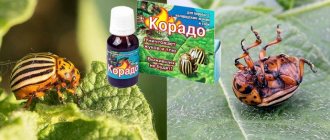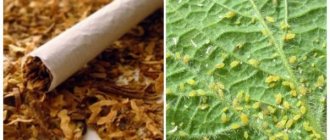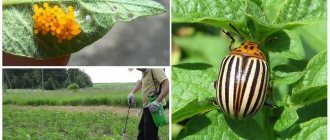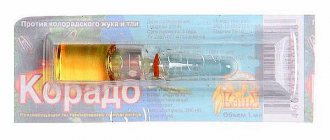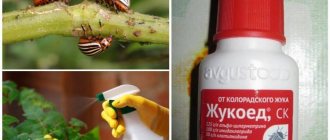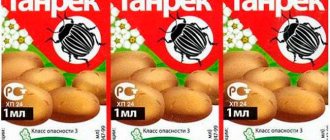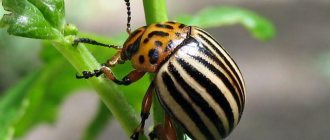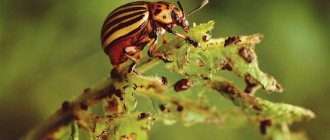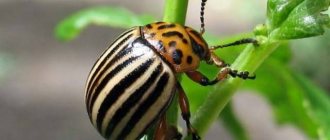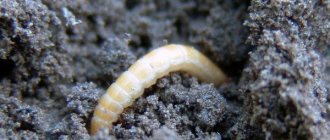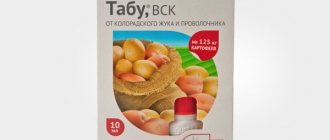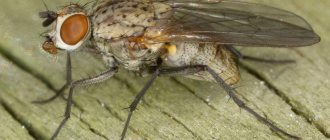The insecticide Corado is produced in the Russian Federation in Nizhny Novgorod by LLC “Vashe Khozyaystvo”. The active substance (AI) of this drug - imidacloprid from the chemical class of neonicotinoids - in the same concentration of 20% (200 g/1 l) is used in several dozen pesticides for similar purposes (Tanrek, Imidor, Prestige, etc.). Their formulations are also the same: ready-to-use solution (VR or P). However, it would be wrong to consider Corado only a fruit and a means of competition: this drug is intended for use in private household plots not only in terms of volume and type of packaging, but also in terms of its full chemical composition, see below. For a presentation of Corado (of an advertising nature), see the video below:
What is the difference?
The full composition of pesticides for spraying treatment includes, in addition to the active ingredients, adhesives (surfactants, surfactants), ballast additives, which to some extent regulate the translaminar and biological activity of the drug (its ability to penetrate plant tissues and effectiveness on objects to be eliminated), and a solvent . The solvent also plays a certain role in the properties and activity of the drug.
While manufacturers willingly disclose the composition and concentration of additives to everyone, branded surfactants, ballast and solvent are a taboo and a sealed secret, known only to the leading specialists of the developer company, especially since there is practically no information on the dangers and toxicological properties of the finished drug surfactant and ballast. influence. But they largely determine the scope of application of the product and the features of its use. Corado's solvent is certainly different from that of other pesticides with neonicotinoids: a pungent odor of some organic volatile liquid spreads from the opened package of the drug.
In terms of general indicators, Corado is the same as its analogues (not complete) at 20% imidacloprid:
- It has high translaminar activity - it is completely absorbed into the plant tissue in 2-3 hours;
- The protective effect is high - correct application (see below) ensures 100% destruction of a pest population of any volume and density at any phase of its development;
- The drug is not phytotoxic;
- Effective against pests resistant to pesticides based on other chemicals;
- Resistance of elimination objects to imidacloprid itself has not been recorded;
- The effectiveness of the drug is practically independent of the weather (imidacloprid is neither photolytic nor hydrolytic);
- Temperature range of effectiveness of the drug is +(12-25) degrees Celsius;
- The degree of danger of imidacloprid for humans and warm-blooded animals is 3 (moderately dangerous substance), but chronic poisoning with microdoses of DV produces long-term negative after-effects, incl. mutagenic and teratogenic (on fetal development in pregnant women);
- In the external environment, imidacloprid persists for a long time (half-life in soil up to 8 months);
- The degree of danger of the drug for bees and aquatic organisms is 1st (extremely dangerous substance).
Note: the craze for such seemingly convenient neonicotinoids has led in a number of countries around the world (the list of which is ever expanding) to the extinction of domestic bees and beneficial wild insects - pollinators and entomophages. This threatens an environmental disaster on a planetary scale. Currently in the EU and some. In other countries, the use of pesticides with neonicotinoids on open ground crops is prohibited.
At the same time, the effect of the drug Corado is noticeably different from agrochemicals for a similar purpose:
- The speed of action is below average - the pests stop feeding within 2-3 hours and die within 2-3 days (apparently, the manufacturer has developed a surfactant that regulates the translaminar activity of the drug);
- For the same alleged reason, the protective effect of Corado is longer, up to 20 days;
- As a consequence of paragraphs. 1 and 2, the effect of the drug on the imago (adult individuals) of the Colorado potato beetle is weakened - the beetles have time to migrate before dying;
- Some ovicidal activity of the drug was noted: a decrease in the volume of oviposition of pests, anomalies in the development of eggs and a decrease in the percentage of larvae hatching from them;
- The dosage and consumption rates of the drug are even less than those of others at 20% imidacloprid. This reduces the cost of one treatment, but in no case gives a reason to neglect precautions, see below;
- Corado in tank mixtures is incompatible with other agrochemicals. However, in private household plots treatment with mixtures is almost never carried out;
- In certain dosages (see below), Corado exhibits fungicidal activity.
Note: the acaricidal activity of neonicotinoids is a myth, most likely generated by “network hamsters” and “sofa barmalogs”. Harmful mites have a significantly different metabolism than insects. After the use of neonicotinoids, a decrease in the number of predatory mites, pest exterminators, was noted on plants. But in laboratory conditions, the LD50 doses for them turn out to be several times and orders of magnitude higher than for insects. But in natural conditions - well, where do the predators have to go, since, excuse me, all the food has died?
Analogs
The drug "Korado" is the only one of its kind, but it has a number of "substitutes". This product, which contains imidacloprid, is produced in Russia, the Czech Republic, India and other countries, and is also included in some types of drugs that do not have such a wide range of applications.
Exactly the same effect is exerted by means called by others, “Confidelin”, “Biotlin”, “Commander”. The drug is produced under the name "Korado". The same company launched the Stozhar product on the market, which rids potato plants of the Colorado potato beetle. It is less harmful to bees.
Application area
The popularity of Corado is caused not only and not so much by the relatively low price combined with catchy advertising. Based on the complex of properties of the drug, it is possible to determine the scope of its use in private household plots:
- Corado, like its chemical “brothers,” is primarily a remedy for the Colorado potato beetle on potatoes and aphids on apple trees.
- At the same time, the drug is applicable against some pests that are “atypical” for neonicotinoids, see below.
- Corado is not only a one-time “first aid” for a massive pest invasion: this drug is applicable as a powerful means of ongoing (planned) control of target objects of elimination.
- For potatoes, in exceptional cases, it is permissible to use the drug twice during the season, and for some. For other crops, 2-fold processing is routine (also see below).
- In the black soil zone and south of Corado, it can be used for up to 3 seasons in a row, without fear of the accumulation of the active substance in the soil.
- Corado is not applicable for protected soil crops (in greenhouses).
Note: in addition to apple trees, Corado from pome fruits is applicable according to the same regulations on quince and medlar (loquat, sheseku). But it is unacceptable to use it on pears, stone fruits and berries - the active substance will penetrate through the cuticle of the ovaries into the ripening fruits and remain in their pulp for an indefinitely long time!
“Colorado” and “fly” Corado
Corado drug against onion and carrot flies
LLC “Vashe Khozyaystvo” offers Corado in 2 commercial formulations: against the Colorado potato beetle and against onion and carrot flies, see fig. on right. The visible difference between them is the granularity of packaging: “Colorado” corado is bottled in ampoules of 1 and 5 ml and in bottles of 10 and 25 ml. Ampoules with a capacity of 1 ml are packaged individually or in blisters of 5 pieces; 5 ml ampoules individually. “Fly” Corado is packaged in blisters in pairs of 2 ml ampoules.
The chemical composition and effect of Corado in any packaging are identical; as they say, “they poured from the same barrel.” The difference in packaging size is explained by ease of use against target objects, see below. But if for some reason it is more convenient for you to poison the “Colorados” with the “fly” Corado or vice versa, do not hesitate - the effect will be the same, because the substance in container units is the same.
Note: the expression “they poured from the same barrel” has a relatively recent origin, from a Soviet joke. A Krokodil correspondent interviews the director of an Armenian wine and cognac company. He asks: “At the competition in Paris, your 3-star cognac won a gold medal, but your 5-star cognac did not reach the finals at all. How do you explain this? He throws up his hands - “I don’t understand. They poured from one barrel."
Corado from cows
In addition to the target elimination targets indicated on the packaging, both Corado formations are equally effective against another pest - the 28-spot or potato ladybug. This cute little bug has not yet gained the sad fame of its striped “colleague,” but in some regions it successfully competes with it in terms of harmfulness.
Pest potato beetle (28 spot) ladybird
The color of the potato ladybug is variable (see figure), even the number of spots is not necessarily 28, but this does not make it any more harmless. In addition, 28-spotted, like all ladybugs (including beneficial entomophages) can be dangerous to humans. From time to time, ladybugs are attacked by some kind of beetle rage; they attack people in masses and bite. Ladybird bites are weak (they do not bite through the skin until it bleeds), but are poisonous. There are known cases where hordes of maddened ladybugs have eaten people to death. Single, extremely rare. Therefore, there is no need to exterminate insectivorous ladybugs, especially since the most useful 7-pointed ones rage much less often than others.
Advantages of the drug
Those who, before using Corado, unsuccessfully fought the Colorado potato beetle with other poisons, note the following advantages:
- Nice price and low consumption.
- Easy to use.
- Suitable for controlling eggs, larvae and adults of Colorado potato and other pests.
- Can be used on different crops (cherries, cabbage, potatoes, currants, cucumbers and tomatoes, onions, carrots).
- Economical. It takes 1 ml of the drug to process a potato field of 1 hundred square meters. This is one dose per ampoule.
- Does not harm animals or humans.
- High efficiency. The action begins after a single application.
- Long shelf life.
Corado kills pests, causing paralysis, and becomes part of its structure, as a result of which the plant becomes stronger, grows better and gains immunity for the entire period of action. Vegetables do not suffer from the use of chemicals, but the pest, which managed to hide from direct contact with the drug by eating the pulp of the greens, receives a dose of poison along with it and dies in two or three days.
Mechanism of action
Chemical formula of imdacloprid
Imidacloprid (chemical formula and its spatial model in the figure on the right) and in Corado remains a neonicotinoid - a neurotoxin (nerve poison) with a specific effect. Imidacloprid causes, so to speak, abnormal discharges in the nicotinic acetylcholine postsynaptic membranes of the synapses of nerve cells, i.e. blocks the transmission of “command” impulses from the central nervous system to muscle cells. As poisoning progresses, involuntary muscle contractions begin, turning into convulsions and complete paralysis, resulting in death. Neonicotinoids have the strongest effect on insects (all without exception); weakest on vertebrates. But the mechanism and consequences of poisoning are the same in all cases, only the lethal dosage is different. Therefore, precautions when working with neonicotinoids should be strictly observed.
Precautions when working with the drug
Corado is a hazard class 3 insecticide, i.e. it has low toxicity for humans, but is very dangerous for bees and fish, and can cause severe poisoning in domestic animals and birds. All work on the preparation and use of the solution must be carried out wearing rubber gloves, special clothing, safety glasses and a respirator. The working solution cannot be prepared in containers used for food products.
Important. Flowers and vegetable crops should not be processed during the flowering period, as this may kill beneficial pollinating insects.
Do not allow the product to come into contact with dill, parsley and other herbs. After this, it will be dangerous to eat them. The prepared working solution cannot be stored. The drug in unopened original packaging is stored in an inaccessible, dark and dry place, separate from food, feed and chemicals. At the same time, the shelf life will be 3 years from the date of manufacture, at t from +5C to +25C.
If the solution gets on the skin, carefully remove it with a dry cotton swab, and wash the area of contact with running water and soap. In case of contact with eyes, rinse them thoroughly with water for 10-15 minutes.
The drug Corado is low-toxic, but if it enters the stomach it can lead to poisoning.
Getting an insecticide into the stomach can cause serious poisoning, the first signs of which will be:
- tremor of the limbs;
- dyspnea;
- dizziness;
- weakened vision;
- heartache.
If at least one such symptom appears, you need to immediately drink several glasses of water and induce vomiting. After that, take activated carbon (1 t/1 kg of weight) and call a doctor.
Even if poisoning has not occurred, after finishing work it is recommended to change clothes, wash your hands thoroughly with soap, rinse your mouth, take a shower and drink a glass of water with activated carbon. Livestock and pets should not be approached or allowed into treated plantings for 7-10 days. During this time, the drug will be completely absorbed and will no longer pose a danger.
Precautionary measures
Security zones for working with the Corado insecticide are established similar to other preparations based on 20% imidacloprid:
- Apiary – 6 km.
- Limitation of the flight of bees in apiaries in the protected zone is 96 hours.
- Children's and medical institutions, recreation areas, feeding stations of wild pollinators and entomophages (nectar-bearing and pollen-bearing plantings) - 150 m.
- Residential buildings, poultry houses, open farmyards, food storage facilities - 50 m.
- Other outbuildings – 15 m.
Considering the high volatility and the possibility of regular use of the Corado drug in hot weather, it is unacceptable to use improvised and/or partially available PPE to work with it. To work with this pesticide (and any other pesticides) in private household plots, you need to purchase a non-professional (cheaper) work suit made of synthetic calender fabric (item A in the figure). Calender fabrics have partially one-way vapor permeability: they do little to prevent the evaporation of sweat and cool the operator’s body, and at the same time they do not allow splashes and vapors to reach him from the outside.
Personal protective equipment for working with Corado insecticide
Note: a calender is still not a spacesuit. Corado should be sprayed directly or at a slight angle downwind, avoiding vapors and splashes of the product on yourself and objects outside the work area.
Other personal protective equipment (item B) must also be selected carefully. Waterproof shoes are enough for your feet (suit pants are worn untucked). Single-layer protective gloves (blue in the figure) are partially vapor-permeable, but in hot weather the hands in them do not get too hot to the point of ulceration, as in heavy 2-3-layer gloves (black in the figure). The same applies to safety glasses: under completely sealed canned glasses (top left in position B), sweat floods the eyes already at +22-23, but lightweight panoramic safety glasses (top right) without a face seal at temperatures below +15-17 pass vapors to the eyes; however, at temperatures below +18, pests are little active and treatment can be postponed.
A cheap anti-dust petal respirator (crossed out in red) is definitely unsuitable for working with pesticides. The filter blade (middle left) can draw in drug vapors when you breathe heavily, so avoid straining when working in it. The optimal respiratory protection is a full-cycle filtering respirator with gas cartridges (middle right), but it is expensive.
Note: the elastic bands of the sleeves of the protective suit are pulled over the cuffs of the gloves.
Corado should be stored under the usual conditions for pesticides: under locking, in a separate non-residential area inaccessible to children and animals. Storing food, medicines and household items in it is unacceptable.
The preparation of Corado working solution is carried out either in the open air or in a non-residential premises equipped with supply and exhaust ventilation. Neutralize spills with a solution of baking soda or soda ash, 2-3 tbsp. l. per liter of water. Those. rags used to neutralize spills on the floor must be burned in a waste incinerator. The collected soil soaked in the preparation is suitable for returning to the ground after calcination over an open fire. After finishing working with Corado, you need to take a shower, wash your work clothes with laundry soap, and neutralize the sprayer and personal protective equipment for your hands, feet and face with a soda solution and rinse with water.
Symptoms of Corado poisoning are trembling of the limbs, abnormal excitability (increased or lethargic; the reaction is individual), nervous tics, difficulty breathing, drooping eyelids. If any of them is detected, you should immediately stop working and consult a doctor: self-help measures will only aggravate the situation, there is no specific antidote, treatment is symptomatic.
Onion fly treatment
Despite its caustic and tearful nature for humans, onions are susceptible to pests. And its worst enemy is the larvae of the onion fly. Their presence becomes obvious when the feather withers or a characteristic smell of rotting appears.
To protect onions from the start, it is recommended to spray the onion sets with Corado solution. To prepare the working mixture, 15 ml of insecticide is diluted in 200 ml of water. This volume of solution is designed for 10 kg of sets. It is also possible to treat young shoots. When the onion produces 2–3 feathers, spray with the preparation dissolved at the rate of 2 ml per 2 liters of water. As in the case of carrots, this volume is calculated for 1 hundred square meters of crop.
Application procedure
Corado working solution for open ground plants is prepared on the basis of a mother solution so that the chemically active solvent does not get on the plants. A measured dose of the drug is poured into 1 liter of lukewarm water (25-28 degrees) and the solution is allowed to stand for 1-5 minutes. In the meantime, fill the sprayer tank halfway, pour the mother solution into it while stirring, and immediately start working, because the working solution must be produced in no more than 4 hours.
Plants are treated according to the usual rules with one exception: the weather must be dry. Working hours are late morning (after the dew has dried) or evening from the subsidence of the day's heat until sunset. The permissible wind force is no more than 5 m/s (thin tree branches sway from time to time). Time before rain – 6 hours.
Corado's working solution for treating seed (see below), due to the low total consumption, is prepared directly in the tank of a hand-held sprayer. Before starting work, the device is kept for approx. 5 minutes with the head removed (with the neck open). The readiness of the solution for use is determined by the absence of the smell of the solvent. You need to sniff chemically: holding the container 15-20 cm from your face, wave your palm over your neck towards you while inhaling. Poking your nose into the neck and sniffing is unacceptable!
Instructions for using the Corado insecticide on private farms are given in table. below. The fungicidal activity of the drug is manifested at a dosage equal to or higher than that indicated in the column for treating onion sets, but at a concentration an order of magnitude lower, the phytotoxicity of the drug is already strongly manifested, therefore exceeding the indicated dosages for treating vegetative plants is unacceptable.
Carrot processing
A small carrot fly, or rather its larvae, can easily deprive you of your carrot harvest. In plants damaged by it, the leaves gradually acquire a reddish tint and dry out over time. The root crop itself rots and loses its presentation and taste. The drug Corado can protect against such a scourge.
To prepare the solution, you will need to dilute the drug at the rate of 2 ml of Corado per 2 liters of water. This volume is enough to process 1 hundred square meters of plantings. In order for the use of the product to give maximum results, treatment against carrot flies is carried out twice: when the pest emerges en masse (at this time the crop has 2–4 leaves) and 3 weeks after the first spraying.
Promotion “Buy CORADO and get a gift!” 2022
To participate in the promotion you need: 1. Purchase a product for controlling the Colorado potato beetle and aphids “CORADO” (10 ml bottle) released in 2021, the packaging of which contains the inscription: “CORADO + GIFT”.
Promotional packaging “Korado” (1 option)
Promotional packaging “Korado” (2nd option)
2. Open the package and find a gift there - the Agrokhimik Test System, used to determine the acidity of the soil, or the Kaput product - mosquito repellent plates.
Promotion period
— from March 15, 2022 to December 31, 2022
The number of gifts corresponds to the number of units of the goods participating in the promotion and is 3,000,000 pieces.
Information about the organizer of the action:
Name of the organizer:
Limited Liability Company “Your Economy”
Legal and postal address:
Russian Federation, 603108, Nizhny Novgorod, Bazovy Proezd, 9
OGRN
1025203566728;
TIN
5261020018;
Checkpoint
525701001
Website on the Internet
-
I bought “CORADO” - I defeated the beetle and received a gift!
Not quite a ladybug
It turns out that among the ladybugs that we loved so much in childhood, we read poems to them (“Ladybug fly to the sky, where your kids eat candy!”), there are those that harm cultivated plants on a par with the Colorado potato beetle.
This is a useful ladybug
The common ladybug, with its bright red hue to its chitinous cover, is considered a beneficial entomophagous insect. It feeds on aphids, scale insects, spider mites, larvae and eggs of leaf beetles, and corn moth. In one day, an adult, for example, destroys more than 100 aphids (larvae up to 70). Our garden really needs such natural bioprotection.
But among the beneficial ladybugs there is a type of herbivorous (phytophagous) that feeds on the tops of potatoes, peppers, eggplants, tomatoes, beans and cucumbers. One of them - epilyachna (lat. Henosepilachna vigintioctopunctata) or potato ladybug - can so devastate the plantings of the “second bread” that only “skeletons” will remain from the tops. This insect has a less bright color and a 28-point pattern on the back, but is just as voracious as the Colorado potato beetle.
Epilyakhna carefully eats away the leaf blades, leaving only hard veins, as a result the leaves turn yellow and fall off, the number of tubers being formed and the level of starch in them decreases. After “dealing” with the young leaves, the insects lay eggs (up to 2 thousand pieces). They can be found on the undersides of potato leaves or in fallen leaves. The eggs hatch into light yellow larvae up to 6 mm long with rows of black spines. These “hedgehogs” attack foliage in the same way, feed intensively, then pupate, turning into a new generation of beetles.
Epilyachnas are distinguished by their tenacity: they are able to withstand 40-degree frosts, but under dense snow cover in the forest floor or a bunch of plant debris. If the winter has little snow, the spring emergence of this insect will not be as widespread.
To protect potato plantings from pests, some gardeners cover their small “strips” with non-woven agricultural material (spunbond, agrotex, window mesh and others). You can build a frame, but simply throwing fabric over a ridge with sprouting potatoes (and covering the edges with soil) will save the plants from the voracious ladybug.
What “works” for a while is dusting the tops with wood ash (3-5 kg per hundred square meters), spraying in early June with an infusion of garlic (250 g of garlic or garlic “arrows” is poured into 10 liters of water for 2 days) or a decoction of wormwood (boil 1 kg of wormwood for 3 l of water for a few minutes, then strain and add water to a volume of 10 l).
But with a large invasion of the 28-spotted potato ladybug, it’s impossible to cope without insecticides. Take Corado for these purposes: spray at the beginning of the appearance of pests on plants before they spread en masse. Do not treat plants in strong winds or during hot weather, before or immediately after rain (preferably in the early morning or evening). Strictly follow the instructions for use during flowering plants for the safety of pollinating insects.
